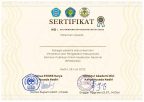THE RELATIONSHIP OF EATING PATTERNS WITH THE INCIDENT OF OBESITY IN ADOLESCENTS OF SMAN 1 KUTOREJO, MOJOKERTO DISTRICT
Keywords:
Diet, Obesity, AdolescentsAbstract
Obesity is commonly known as overweight or the condition of fat accumulation in the body. The high incidence of obesity in adolescents increases the risk of metabolic disorders and degenerative diseases such as heart disease and blockage of blood vessels in adulthood [1]. The incidence of obesity in Mojokerto Regency is 5.92% at the age of 13-15 years and 8.50% at the age of 16-18 years [2]. The purpose of this study was to analyze the relationship between diet and the incidence of obesity in adolescents. Cross-sectional study design with BMI measurement method, completed with FFQ questionnaire and 24-hour food recall in 48 adolescents of SMAN 1 Kutorejo, Mojokerto Regency with simple rondom sampling technique. The results of the study were based on the type of food ingredients according to PGS on carbohydrate sources, animal protein, vegetables, fruits 0 (0%), vegetable protein 3 (6.3%), diet based on the amount of intake both in energy 13 (27.1%), protein 6 (12.5%), fat 12 (25%), carbohydrates 1 (2.1%). And diets based on food frequency are often on carbohydrate and vegetable protein sources 48(100%), animal protein 38(79.2%), vegetables 34(70.8%), fruits 11(22.9%). The results of the spearmen rank test showed no relationship between the type of carbohydrate sources, animal protein, vegetable protein, vegetables, and fruits, the amount of energy intake, fat and carbohydrates, the frequency of carbohydrate sources, vegetable protein, animal protein, vegetables and fruits with the incidence of adolescent obesity SMAN 1 Kutorejo, Mojokerto Regency. There is a relationship between the amount of protein intake and the incidence of obesity in adolescents SMAN 1 Kutorejo P = 0.176 >0.05. The advice of the students to adjust the type, amount and frequency of eating 3 times a day with balanced nutritional portions. The school pays more attention to the nutritional status of students and prepares healthy canteen facilities as a means of education about eating balanced nutrition.
Downloads
Published
Issue
Section
License
Copyright (c) 2024 Proceedings of the National Health Scientific Publication Seminar

This work is licensed under a Creative Commons Attribution 4.0 International License.







